Energy-Aware Dynamic DU Selection and NF Relocation in O-RAN Using Actor–Critic Learning
Abstract
:1. Introduction
2. Related Work
3. System Model
3.1. Energy Consumption and Delay Models
3.2. System Constraints
3.3. Problem Definition
4. Actor–Critic Solution
4.1. RL Model
4.2. Soft Actor–Critic Energy Aware Dynamic DU Selection/NF Placement Scheme (SA2C-EADDUS)
- The critic’s neural network is used to estimate the corresponding value function for aligning the actor’s actions. In the proposed scheme we used two critics to minimize the overestimation bias.
- The actor’s neural network is used to estimate proper action (choosing the best DU for executing NF) during each time interval.
5. Performance Evaluation
5.1. Delay and Priority Aware Actor–Critic RB Allocation Algorithm (A2C-RBA)
5.2. Deep-Reinforcement Learning-Based Energy-Aware Dynamic DU Selection Scheme (DRL-EADDUS)
5.3. Heuristic DU Selection Method (Heuristic-DUS)
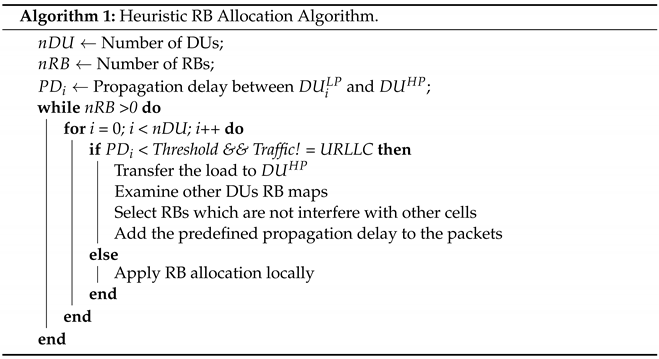
5.4. Simulation Results
5.4.1. Convergence
5.4.2. Energy Efficiency
5.4.3. Comparison with the MILP Solution
5.4.4. Delay
5.4.5. Packet Delivery Ratio
6. Conclusions
Author Contributions
Funding
Conflicts of Interest
Notations
| Sets | Explanation |
| set of RBs in one time interval | |
| set of time intervals | |
| set of UEs | |
| tuple of demands | |
| set of | |
| type of traffic | |
| Variables | Explanation |
| indicates is assigned for | |
| indicates NFs of l migrates to in t | |
| indicates any r in is assigned for | |
| user traffic indicator | |
| Given Data | Explanation |
| propagation delay | |
| fixed energy consumption at l | |
| dynamic energy consumption coefficient at l | |
| total energy consumption at | |
| max service rate | |
| user traffic demand size | |
| delay budget | |
| max. number of that can migrate their NFs | |
| user & map | |
| length of transmission time interval | |
| W | energy consumption weight in objective function |
| scaling factor between en. cons. and mean delay |
References
- Klinkowski, M. Latency-Aware DU/CU Placement in Convergent Packet-Based 5G Fronthaul Transport Networks. Appl. Sci. 2020, 10, 7429. [Google Scholar] [CrossRef]
- Semov, P.; Koleva, P.; Tonchev, K.; Poulkov, V.; Cooklev, T. Evolution of mobile networks and C-RAN on the road beyond 5G. In Proceedings of the 2020 43rd International Conference on Telecommunications and Signal Processing (TSP), Milan, Italy, 7–9 July 2020; IEEE: Piscataway, NJ, USA, 2020; pp. 392–398. [Google Scholar]
- Dryjanski, M.; Kułacz, Ł.; Kliks, A. Toward Modular and Flexible Open RAN Implementations in 6G Networks: Traffic Steering Use Case and O-RAN xApps. Sensors 2021, 21, 8173. [Google Scholar] [CrossRef] [PubMed]
- Yi, B.; Wang, X.; Li, K.; Huang, M. A comprehensive survey of network function virtualization. Comput. Netw. 2018, 133, 212–262. [Google Scholar] [CrossRef]
- Gilson, M.; Mackenzie, R.; Sutton, A.; Huang, J. NGMN Overview on 5G RAN Functional Decomposition; NGMN Alliance: Frankfurt am Main, Germany, 2018. [Google Scholar]
- Pamuklu, T.; Ersoy, C. GROVE: A Cost-Efficient Green Radio Over Ethernet Architecture for Next Generation Radio Access Networks. IEEE Trans. Green Commun. Netw. 2021, 5, 84–93. [Google Scholar] [CrossRef]
- Mollahasani, S.; Erol-Kantarci, M.; Wilson, R. Dynamic CU-DU Selection for Resource Allocation in O-RAN Using actor–critic Learning. In Proceedings of the IEEE Global Communications Conference (GLOBECOM), Madrid, Spain, 7–11 December 2021. [Google Scholar]
- Wu, J.; Zhang, Y.; Zukerman, M.; Yung, E.K.N. Energy-efficient base-stations sleep-mode techniques in green cellular networks: A survey. IEEE Commun. Surv. Tutor. 2015, 17, 803–826. [Google Scholar] [CrossRef]
- Oh, E.; Son, K.; Krishnamachari, B. Dynamic base station switching-on/off strategies for green cellular networks. IEEE Trans. Wirel. Commun. 2013, 12, 2126–2136. [Google Scholar] [CrossRef]
- Niu, Z. TANGO: Traffic-aware network planning and green operation. IEEE Wirel. Commun. 2011, 18, 25–29. [Google Scholar] [CrossRef]
- Mollahasani, S.; Onur, E. Density-aware, energy-and spectrum-efficient small cell scheduling. IEEE Access 2019, 7, 65852–65869. [Google Scholar] [CrossRef]
- Qian, M.; Hardjawana, W.; Shi, J.; Vucetic, B. Baseband processing units virtualization for cloud radio access networks. IEEE Wirel. Commun. Lett. 2015, 4, 189–192. [Google Scholar] [CrossRef]
- Wang, X.; Thota, S.; Tornatore, M.; Chung, H.S.; Lee, H.H.; Park, S.; Mukherjee, B. Energy-efficient virtual base station formation in optical-access-enabled cloud-RAN. IEEE J. Sel. Areas Commun. 2016, 34, 1130–1139. [Google Scholar] [CrossRef] [Green Version]
- Sahu, B.J.; Dash, S.; Saxena, N.; Roy, A. Energy-efficient BBU allocation for green C-RAN. IEEE Commun. Lett. 2017, 21, 1637–1640. [Google Scholar] [CrossRef]
- Saxena, N.; Roy, A.; Kim, H. Traffic-aware cloud RAN: A key for green 5G networks. IEEE J. Sel. Areas Commun. 2016, 34, 1010–1021. [Google Scholar] [CrossRef]
- Malandrino, F.; Chiasserini, C.F.; Casetti, C.; Landi, G.; Capitani, M. An Optimization-Enhanced MANO for Energy-Efficient 5G Networks. IEEE/ACM Trans. Netw. 2019, 27, 1756–1769. [Google Scholar] [CrossRef] [Green Version]
- Larsen, L.M.; Checko, A.; Christiansen, H.L. A survey of the functional splits proposed for 5G mobile crosshaul networks. IEEE Commun. Surv. Tutor. 2018, 21, 146–172. [Google Scholar] [CrossRef] [Green Version]
- Shehata, M.; Elbanna, A.; Musumeci, F.; Tornatore, M. Multiplexing gain and processing savings of 5G radio-access-network functional splits. IEEE Trans. Green Commun. Netw. 2018, 2, 982–991. [Google Scholar] [CrossRef] [Green Version]
- Alabbasi, A.; Wang, X.; Cavdar, C. Optimal processing allocation to minimize energy and bandwidth consumption in hybrid CRAN. IEEE Trans. Green Commun. Netw. 2018, 2, 545–555. [Google Scholar] [CrossRef]
- Akoush, S.; Sohan, R.; Rice, A.; Moore, A.W.; Hopper, A. Predicting the performance of virtual machine migration. In Proceedings of the 2010 IEEE International Symposium on Modeling, Analysis and Simulation of Computer and Telecommunication Systems, Miami Beach, FL, USA, 17–19 August 2010; IEEE: Piscataway, NJ, USA, 2010; pp. 37–46. [Google Scholar]
- Zhan, Z.H.; Liu, X.F.; Gong, Y.J.; Zhang, J.; Chung, H.S.H.; Li, Y. Cloud computing resource scheduling and a survey of its evolutionary approaches. ACM Comput. Surv. (CSUR) 2015, 47, 1–33. [Google Scholar] [CrossRef] [Green Version]
- Elsayed, M.; Erol-Kantarci, M. AI-enabled future wireless networks: Challenges, opportunities, and open issues. IEEE Veh. Technol. Mag. 2019, 14, 70–77. [Google Scholar] [CrossRef]
- Şahin, T.; Khalili, R.; Boban, M.; Wolisz, A. Reinforcement learning scheduler for vehicle-to-vehicle communications outside coverage. In Proceedings of the 2018 IEEE Vehicular Networking Conference (VNC), Taipei, Taiwan, 5–7 December 2018; IEEE: Piscataway, NJ, USA, 2018; pp. 1–8. [Google Scholar]
- Pamuklu, T.; Erol-Kantarci, M.; Ersoy, C. Reinforcement Learning Based Dynamic Function Splitting in Disaggregated Green Open RANs. In Proceedings of the IEEE International Conference on Communications, Montreal, QC, Canada, 14–23 June 2021. [Google Scholar]
- Elsayed, M.; Erol-Kantarci, M.; Yanikomeroglu, H. Transfer Reinforcement Learning for 5G-NR mm-Wave Networks. IEEE Trans. Wirel. Commun. 2020, 20, 2838–2849. [Google Scholar] [CrossRef]
- Zhang, T.; Shen, S.; Mao, S.; Chang, G.K. Delay-aware Cellular Traffic Scheduling with Deep Reinforcement Learning. In Proceedings of the GLOBECOM 2020—2020 IEEE Global Communications Conference, Taipei, Taiwan, 7–11 December 2020; pp. 1–6. [Google Scholar]
- Chen, G.; Zhang, X.; Shen, F.; Zeng, Q. Two Tier Slicing Resource Allocation Algorithm Based on Deep Reinforcement Learning and Joint Bidding in Wireless Access Networks. Sensors 2022, 22, 3495. [Google Scholar] [CrossRef]
- Mollahasani, S.; Erol-Kantarci, M.; Hirab, M.; Dehghan, H.; Wilson, R. actor–critic Learning Based QoS-Aware Scheduler for Reconfigurable Wireless Networks. IEEE Trans. Netw. Sci. Eng. 2021, 9, 45–54. [Google Scholar] [CrossRef]
- Pamuklu, T.; Mollahasani, S.; Erol-Kantarci, M. Energy-Efficient and Delay-Guaranteed Joint Resource Allocation and DU Selection in O-RAN. In Proceedings of the 5G World Forum (5GWF), Montreal, QC, Canada, 13–15 October 2021. [Google Scholar]
- O-RAN Alliance. O-RAN-WG1-O-RAN Architecture Description—v04.00.00; Technical Specification; O-RAN Alliance: Alfter, Germany, 2021. [Google Scholar]
- Yu, Y.J.; Pang, A.C.; Hsiu, P.C.; Fang, Y. Energy-efficient downlink resource allocation for mobile devices in wireless systems. In Proceedings of the 2013 IEEE Global Communications Conference (GLOBECOM), Atlanta, GA, USA, 9–13 December 2013; IEEE: Piscataway, NJ, USA, 2013; pp. 4692–4698. [Google Scholar]
- Bonati, L.; D’Oro, S.; Polese, M.; Basagni, S.; Melodia, T. Intelligence and Learning in O-RAN for Data-Driven NextG Cellular Networks. IEEE Commun. Mag. 2021, 59, 21–27. [Google Scholar] [CrossRef]
- ITU. ITU-T Recommendation G Suppl. 66. In 5G Wireless Fronthaul Requirements in a Passive Optical Network Context; Technical Report; International Telecommunications Union: Geneva, Switzerland, 2018. [Google Scholar]
- 3GPP. Table 6.1.7-A: Standardized QCI Characteristics from 3GPP TS 23.203 V16.1.0; Technical Report; 3GPP: Sophia Antipolis, France, 2020. [Google Scholar]
- Gawłowicz, P.; Zubow, A. NS-3 meets openai gym: The playground for machine learning in networking research. In Proceedings of the 22nd International ACM Conference on Modeling, Analysis and Simulation of Wireless and Mobile Systems, Miami Beach, FL, USA, 25–29 November 2019; pp. 113–120. [Google Scholar]
- Brockman, G.; Cheung, V.; Pettersson, L.; Schneider, J.; Schulman, J.; Tang, J.; Zaremba, W. Openai gym. arXiv 2016, arXiv:1606.01540. [Google Scholar]

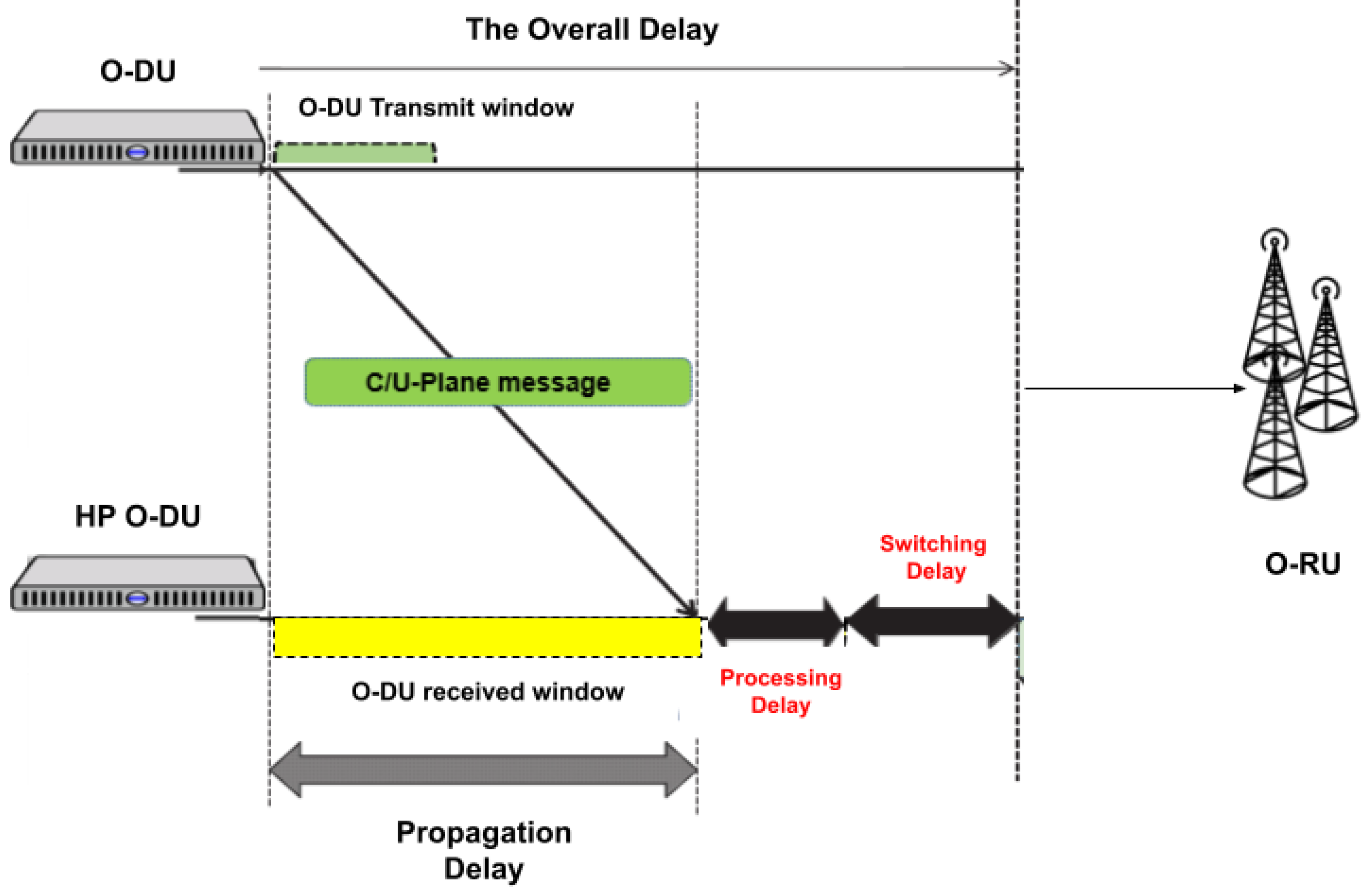
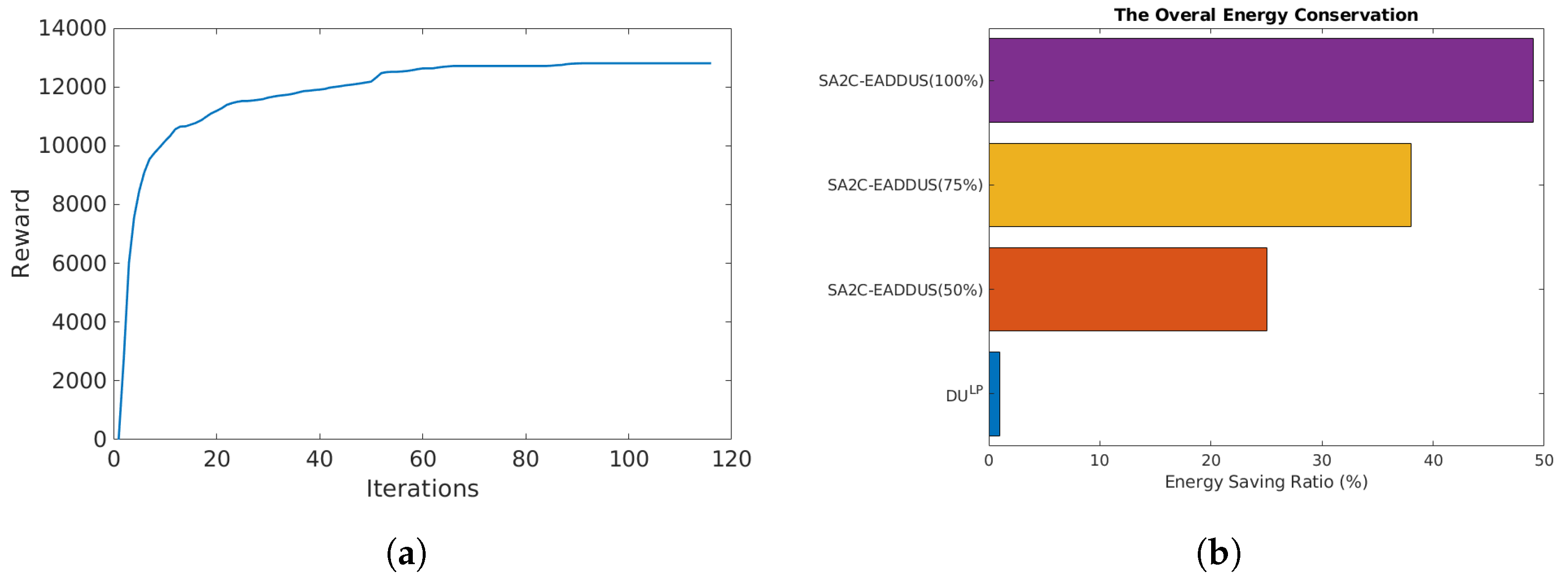
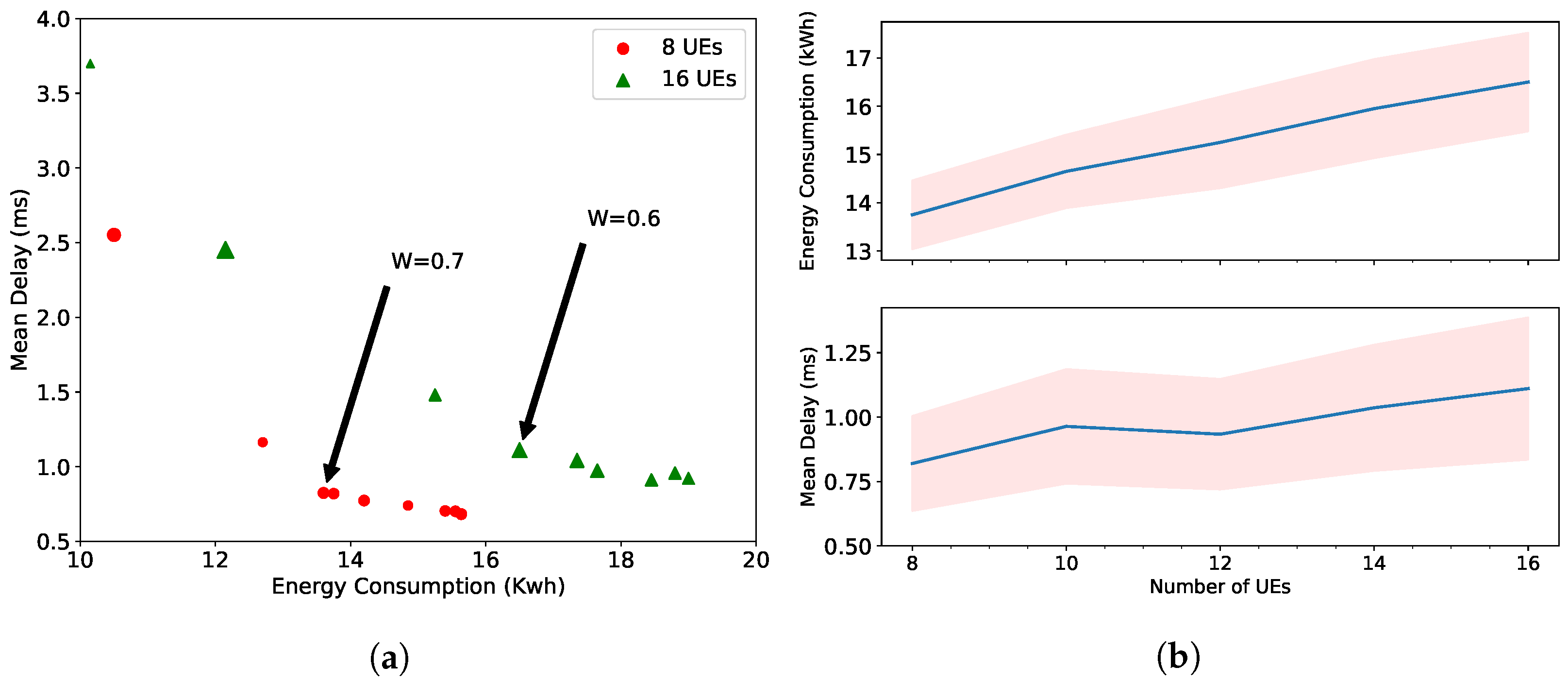

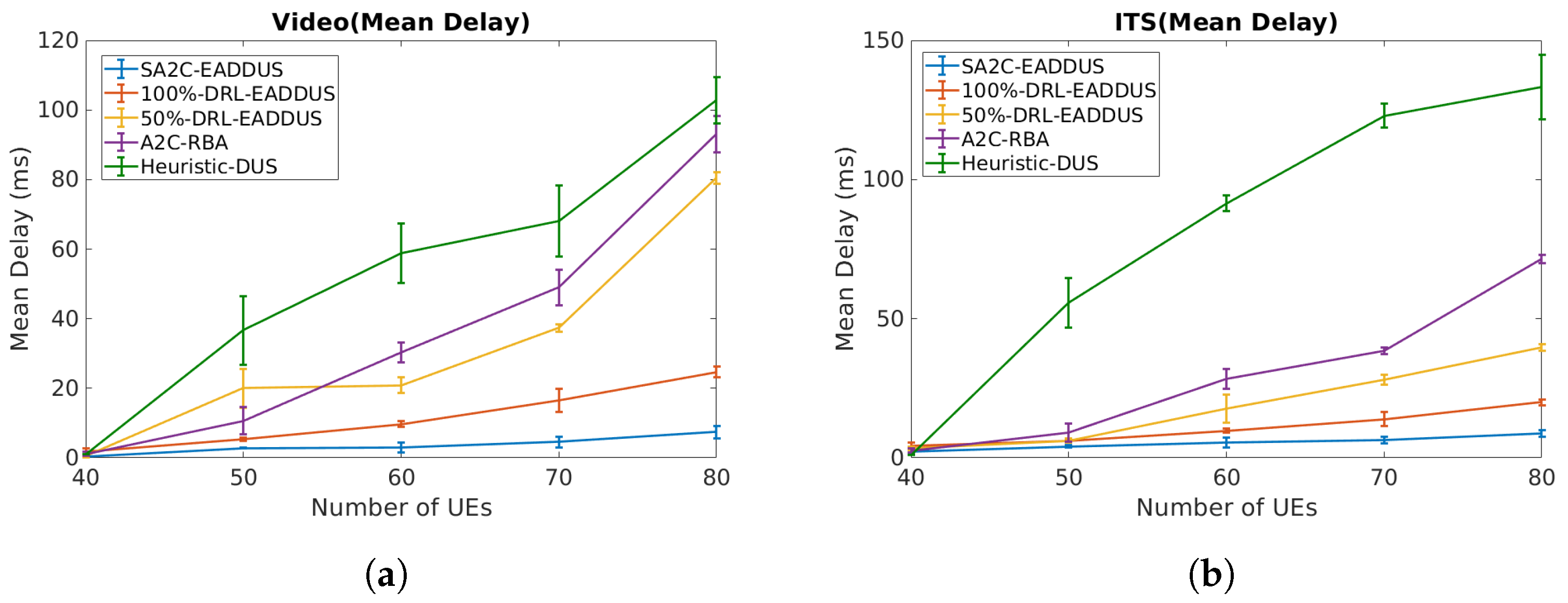

| QCI | Resource Type | Priority | Packet Delay Budget | Service Example |
|---|---|---|---|---|
| 2 | GBR | 40 | 150 ms | Live stream Video |
| 84 | GBR | 24 | 30 ms | ITS |
| Parameters | Value |
|---|---|
| Number of neurons | 1024 × 512 layers (Actor + Critic) |
| DU selec./scheduler algorithms | SA2C-EADDUS, DRL-EADDUS, A2C-RBA |
| Number of BSs | 4 |
| Number of UEs | 40, 60, 80 |
| Maximum Traffic load per UE (Downlink) | 512 kbps |
| Traffic types | Video, ITS |
| Propagation delay | 2–5 ms |
| Reward’s weights | and |
| Number of RBs | 12, 100 |
| Discount factor | 0.9 |
| Actor learning-rate | 0.01 |
| Critic learning-rate | 0.05 |
Publisher’s Note: MDPI stays neutral with regard to jurisdictional claims in published maps and institutional affiliations. |
© 2022 by the authors. Licensee MDPI, Basel, Switzerland. This article is an open access article distributed under the terms and conditions of the Creative Commons Attribution (CC BY) license (https://creativecommons.org/licenses/by/4.0/).
Share and Cite
Mollahasani, S.; Pamuklu, T.; Wilson, R.; Erol-Kantarci, M. Energy-Aware Dynamic DU Selection and NF Relocation in O-RAN Using Actor–Critic Learning. Sensors 2022, 22, 5029. https://doi.org/10.3390/s22135029
Mollahasani S, Pamuklu T, Wilson R, Erol-Kantarci M. Energy-Aware Dynamic DU Selection and NF Relocation in O-RAN Using Actor–Critic Learning. Sensors. 2022; 22(13):5029. https://doi.org/10.3390/s22135029
Chicago/Turabian StyleMollahasani, Shahram, Turgay Pamuklu, Rodney Wilson, and Melike Erol-Kantarci. 2022. "Energy-Aware Dynamic DU Selection and NF Relocation in O-RAN Using Actor–Critic Learning" Sensors 22, no. 13: 5029. https://doi.org/10.3390/s22135029
APA StyleMollahasani, S., Pamuklu, T., Wilson, R., & Erol-Kantarci, M. (2022). Energy-Aware Dynamic DU Selection and NF Relocation in O-RAN Using Actor–Critic Learning. Sensors, 22(13), 5029. https://doi.org/10.3390/s22135029









